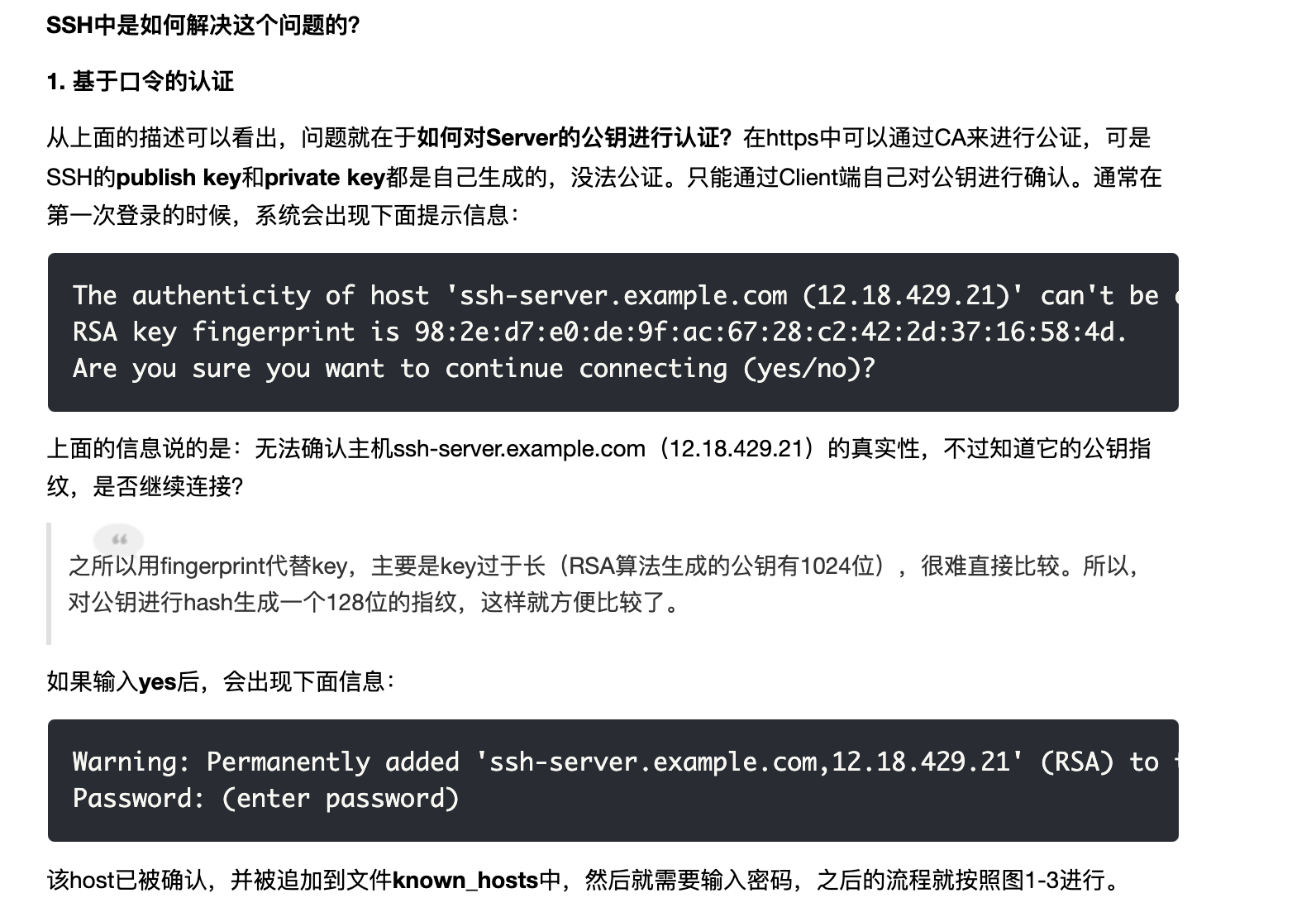SSH(远程连接工具)连接原理:ssh服务是一个守护进程(demon),系统后台监听客户端的连接,ssh服务端的进程名为sshd,负责实时监听客户端的请求(IP 22端口),包括公共秘钥等交换等信息。
ssh服务端由2部分组成: openssh(提供ssh服务) openssl(提供加密的程序)
ssh的客户端可以用 XSHELL,Securecrt, Mobaxterm等工具进行连接
SSH的工作机制
服务器启动的时候自己产生一个密钥(768bit公钥),本地的ssh客户端发送连接请求到ssh服务器,服务器检查连接点客户端发送的数据和IP地址,确认合法后发送密钥(768bits)给客户端,此时客户端将本地私钥(256bit)和服务器的公钥(768bit)结合成密钥对key(1024bit),发回给服务器端,建立连接通过key-pair数据传输。

1.远程Server收到Client端用户TopGun的登录请求,Server把自己的公钥发给用户。
2.Client使用这个公钥,将密码进行加密。
3.Client将加密的密码发送给Server端。
4.远程Server用自己的私钥,解密登录密码,然后验证其合法性。
5.若验证结果,给Client相应的响应
Client端如何保证接受到的公钥就是目标Server端的?


- 1.Client将自己的公钥存放在Server上,追加在文件authorized_keys中。
- 2.Server端接收到Client的连接请求后,会在authorized_keys中匹配到Client的公钥pubKey,并生成随机数R,用Client的公钥对该随机数进行加密得到pubKey(R)
,然后将加密后信息发送给Client。 - 3.Client端通过私钥进行解密得到随机数R,然后对随机数R和本次会话的SessionKey利用MD5生成摘要Digest1,发送给Server端。
- 4.Server端会也会对R和SessionKey利用同样摘要算法生成Digest2。
- 5.Server端会最后比较Digest1和Digest2是否相同,完成认证过程。
SSH的加密技术
加密技术:传输过程,数据加密。
1.SSH1没有对客户端的秘钥进行校验,很容易被植入恶意代码
2.SSH2增加了一个确认联机正确性的Diffe_Hellman机制,每次数据的传输,Server都会检查数据来源的正确性,避免黑客入侵。
SSH2支持RSA和DSA密钥
DSA:digital signature Algorithm 数字签名
RSA:既可以数字签名又可以加密
SSH知识小结
1.SSH是安全的加密协议,用于远程连接Linux服务器
2.SSH的默认端口是22,安全协议版本是SSH2
3.SSH服务器端主要包含2个服务功能SSH连接和SFTP服务器
4.SSH客户端包含ssh连接命令和远程拷贝scp命令等
如何防止SSH登录入侵
1.密钥登录,更改端口
2.牤牛阵法
3.监听本地内网IP(ListenAddress 192.168.25.*)
SSH功能大全
1.登录 `` ``ssh` `-p22 omd@192.168.25.137 `` ``2.直接执行命令 -->最好全路径 `` ``ssh` `root@192.168.25.137 ``ls` `-ltr ``/backup/data` ` ``==>``ssh` `root@192.168.25.137 ``/bin/ls` `-ltr ``/backup/data` ` ``3.查看已知主机 `` ``cat` `/root/``.``ssh``/known_hosts`` ``4.``ssh``远程执行``sudo``命令`` ``ssh` `-t omd@192.168.25.137 ``sudo` `rsync` `hosts ``/etc/` ` ``5.``scp` ` ``1.功能 -->远程文件的安全(加密)拷贝 `` ``scp` `-P22 -r -p ``/home/omd/h``.txt omd@192.168.25.137:``/home/omd/` ` ``2.``scp``知识小结 `` ``scp``是加密远程拷贝,``cp``为本地拷贝 `` ``可以推送过去,也可以拉过来 `` ``每次都是全量拷贝(效率不高,适合第一次),增量拷贝用``rsync` ` ``6.``ssh``自带的``sftp``功能 `` ``1.Window和Linux的传输工具 `` ``wincp filezip `` ``sftp` `-->基于``ssh``的安全加密传输 `` ``samba `` ``2.``sftp``客户端连接 `` ``sftp` `-oPort=22 root@192.168.25.137 `` ``put ``/etc/hosts` `/tmp` ` ``get ``/etc/hosts` `/home/omd` ` ``3.``sftp``小结: `` ``1.linux下使用命令: ``sftp` `-oPort=22 root@x.x.x.x `` ``2.put加客户端本地路径上传 `` ``3.get下载服务器端内容到本地 `` ``4.远程连接默认连接用户的家目录
ssh常见命令参数
usage: ``ssh` `[-1246AaCfgKkMNnqsTtVvXxYy] [-b bind_address] [-c cipher_spec]`` ``[-D [bind_address:]port] [-e escape_char] [-F configfile]`` ``[-i identity_file] [-L [bind_address:]port:host:hostport]`` ``[-l login_name] [-m mac_spec] [-O ctl_cmd] [-o option] [-p port]`` ``[-R [bind_address:]port:host:hostport] [-S ctl_path]`` ``[-W host:port] [-w local_tun[:remote_tun]]`` ``[user@]``hostname` `[``command``]
关于后台ssh服务的相关
# 查询openssl软件`` ``rpm -qa openssh openssl``# 查询sshd进程`` ``ps` `-ef | ``grep` `ssh`` ``--> ``/usr/sbin/sshd``# 查看ssh端口`` ``netstat` `-lntup | ``grep` `ssh` ` ``ss | ``grep` `ssh` `(效果同上,同下,好用)`` ``netstat` `-a | ``grep` `ssh``(记住这个)`` ``netstat` `-lnt | ``grep` `22 ==> 查看22端口有没有开``/ssh``服务有没有开启`` ``技巧: ``netstat` `-lnt | ``grep` `ssh` `| ``wc` `-l -->只要大于2个就是``ssh``服务就是好的``# 查看ssh的秘钥目录`` ``ll ``/root/``.``ssh``/known_hosts` `# 当前用户家目录的.ssh目录下``# ssh的配置文件`` ``cat` `/etc/ssh/sshd_config` `# ssh服务的关闭`` ``service sshd stop``# ssh服务的开启:`` ``service sshd start``# ssh服务的重启`` ``service sshd reload [停止进程后重启] ==> 推荐`` ``service sshd restart [干掉进程后重启] ==> 不推荐``# ssh远程登录`` ``ssh` `192.168.1.100 ``# 默认利用当前宿主用户的用户名登录`` ``ssh` `omd@192.168.1.100 ``# 利用远程机的用户登录`` ``ssh` `omd@192.168.1.100 -o stricthostkeychecking=no ``# 首次登陆免输yes登录`` ``ssh` `omd@192.168.1.100 ``"ls /home/omd"` `# 当前服务器A远程登录服务器B后执行某个命令`` ``ssh` `omd@192.168.1.100 -t ``"sh /home/omd/ftl.sh"` `# 当前服务器A远程登录服务器B后执行某个脚本
ssh免密设置
1、进入用户的家目录
[root@localhost ~]``# cd /root/.ssh/ 【root用户就在root目录下的.ssh目录】``[root@localhost ~]``# cd /home/omd/.ssh/ 【普通用户就是在家目录下的.ssh目录】
2、根据DSA算法生成私钥和公钥【默认建立在当前用户的家目录】
[root@localhost .``ssh``]``# ssh-keygen -t dsa # 一路回车即可`` ``id_dsa -->私钥(钥匙) `` ``id_dsa.pub -->公钥(锁)
3.拷贝公钥给目标服务器
[root@localhost .``ssh``]``# ssh-copy-id -i id_dsa.pub omd@192.168.25.110 【 使用ssh登录的默认端口22】``[root@localhost .``ssh``]``# ssh-copy-id -i id_dsa.pub –p 666 omd@192.168.25.120 【使用ssh登录设置的端口666】

\4. 查看目标服务器生成的文件
[omd@localhost .``ssh``]$ ll ``/home/omd/``.``ssh``/authorized_keys
\5. 免密码登录目标服务器
ssh` `omd@192.168.25.110
\6. 总结一下钥匙和锁的关系
1.多个钥匙开一把锁`` ``把id_dsa.pub 复制给各个服务器` `2.一个钥匙开duobasuo`` ``把id_dsa 传给各个服务器`` ``把id_dsa 传给自己
ssh排查问题
1.判断物理链路是否通 ``ping` `192.168.25.130 线路 | 防火墙 | 是否同一个网的`` ``ping` `本身是icmp协议``2.判断服务是否正常
telnet 192.168.25.130 22
3.Linux防火墙
service iptables status ==> ``/etc/init``.d``/iptables` `status
4.打开``ssh``的调测进行观察
ssh` `-vvv omd@192.168.1.100
SSH批量分发与管理方案小结
1.利用root做ssh key验证
优点:简单,易用
缺点:安全性能差,无法禁止root远程连接
2.利用普通用户omd –>推荐
思路:把要分发的文件拷贝到服务器用户的家目录,然后利用sudo提权拷贝分发的文件和对应目录
优点:安全
缺点:复杂,配置麻烦
1.sudo提权
echo ‘omd All=(All) NOPASSWD:/usr/bin/rsync’ >> /etc/sudoers
visudo -c
grep omd /etc/sudoers
2.ssh分发到服务器的家目录
ssh -p22 -r /etc/hosts omd@192.168.25.137:~
3.ssh使用sudo复制到目标服务器的/etc
ssh -t omd@192.168.25.137 sudo rsync hosts /etc/
3.拓展方案2,不用sudo,而是设置suid对固定命令提权
优点:相当安全
缺点:复杂,安全性较差,任何人都可以处理带有suid权限的命令
1.which rsync
2.chmod 4755 /usr/bin/rsync
ssh章节小结
1.ssh远程的加密连接协议,相关软件openssh,openssl
2.默认端口22
3.ssh版本协议
4.服务器ssh连接,ftp连接,sshd守护进程,开机启动
5.ssh客户端重要命令:ssh(用户登录&&远程命令),scp,sftp,
6.安全验证方式:口令,密钥 学习原理
7.ssh服务优化:改端口,改监听,no root,no empty,no DNS,
8.ssh密钥对,公钥在服务器端,私钥在客户端
修改ssh服务的启动文件sshd的几个点
1-1修改 ``/etc/ssh/sshd_config``<br> GSSAPIAuthentication ``yes` `解决一台服务器管理多个``ssh``服务`` ``UseDNS no 加快响应速度因为在内网环境下`` ``PermitRootLogin no 不运行root用户直接登录`` ``Port 11544 更改访问端口号`` ``ListenAddress 192.168.25.130 只监听内网的IP`` ``Match User anoncvs 当前环境允许登录的用户`` ``PermitRootLogin no 是否允许root用户登录,一般不允许开``1-2重启服务`` ``service sshd restart 写入命令进内存`` ``service sshd reload(优先) reload是一个平滑的访问,不影响用户使用``1-3查看连接端口`` ``netstat` `-an | ``grep` `EST
SSH跳过HostKeyChecking,不用输入yes
SSH跳过输入ssh跳过RSA key fingerprint输入yes/no
在配置大量的节点之间需要ssh连通的时候,如果自动复制很多节点,都需要输入yes,两两节点之间都要互通一次,这样会造成很大的麻烦
**解决1;**修改配置文件/etc/ssh/ssh_config
找 到 # StrictHostKeyChecking ask ``修改为:StrictHostKeyChecking ``no
解决2: 添加参数 –o 【o=option】
ssh root@192.168.25.133 -o ``"StrictHostKeyChecking no"

scp -o ``"StrictHostKeyChecking no"` `newfile.txt <a href=``"mailto:root@192.168.25.133:/root"` `rel=``"noopener nofollow"``>root@192.168.25.133:/root</a>

ssh带密码登录之sshpass的安装
【下载地址】https://sourceforge.net/projects/sshpass/files/latest/download
上传文件到服务器

CentOS下安装:
[root@localhost ~]# tar xf sshpass-1.06.tar.gz ``[root@localhost ~]# cd sshpass-1.06``[root@localhost sshpass-1.06]# ./configure ``[root@localhost sshpass-1.06]# make && make install

检查是否安装成功:
[root@localhost sshpass-1.06]# which sshpass``/usr/``local``/bin/sshpass

远程登录主机:
sshpass -p FTL600@HH ssh omd@192.168.25.110 -o ``"StrictHostKeyChecking no"

注意:如果是第一次登录,需要输入手动yes,此时sshpass并不会给提示,所以登录异常
Ubuntu下安装方法一[推荐]:简单
omd@omd-virtual-machine:~/sshpass-1.06$ sudo apt install sshpass

安装成功:
omd@omd-virtual-machine:~/sshpass-1.06$ which sshpass

Ubuntu下安装方法二:
omd@omd-virtual-machine:~$ tar xf sshpass-1.06.tar.gz ``omd@omd-virtual-machine:~$ cd sshpass-1.06/``omd @omd-virtual-machine:~/sshpass-1.06$ ./configure ``omd@omd-virtual-machine:~/sshpass-1.06$ sudo make && make install``其同CentOS下安装
附ssh的配置文件
/etc/ssh/sshd_config
[root@localhost .``ssh``]``# cat /etc/ssh/sshd_config ``# $OpenBSD: sshd_config,v 1.80 2008/07/02 02:24:18 djm Exp $` `# This is the sshd server system-wide configuration file. See``# sshd_config(5) for more information.` `# This sshd was compiled with PATH=/usr/local/bin:/bin:/usr/bin` `# The strategy used for options in the default sshd_config shipped with``# OpenSSH is to specify options with their default value where``# possible, but leave them commented. Uncommented options change a``# default value.` `#Port 22``#AddressFamily any``#ListenAddress 0.0.0.0``#ListenAddress ::` `# Disable legacy (protocol version 1) support in the server for new``# installations. In future the default will change to require explicit``# activation of protocol 1``Protocol 2` `# HostKey for protocol version 1``#HostKey /etc/ssh/ssh_host_key``# HostKeys for protocol version 2``#HostKey /etc/ssh/ssh_host_rsa_key``#HostKey /etc/ssh/ssh_host_dsa_key` `# Lifetime and size of ephemeral version 1 server key``#KeyRegenerationInterval 1h``#ServerKeyBits 1024` `# Logging``# obsoletes QuietMode and FascistLogging``#SyslogFacility AUTH``SyslogFacility AUTHPRIV``#LogLevel INFO` `# Authentication:` `#LoginGraceTime 2m``#PermitRootLogin yes``#StrictModes yes``#MaxAuthTries 6``#MaxSessions 10` `#RSAAuthentication yes``#PubkeyAuthentication yes``#AuthorizedKeysFile .ssh/authorized_keys``#AuthorizedKeysCommand none``#AuthorizedKeysCommandRunAs nobody` `# For this to work you will also need host keys in /etc/ssh/ssh_known_hosts``#RhostsRSAAuthentication no``# similar for protocol version 2``#HostbasedAuthentication no``# Change to yes if you don't trust ~/.ssh/known_hosts for``# RhostsRSAAuthentication and HostbasedAuthentication``#IgnoreUserKnownHosts no``# Don't read the user's ~/.rhosts and ~/.shosts files``#IgnoreRhosts yes` `# To disable tunneled clear text passwords, change to no here!``#PasswordAuthentication yes``#PermitEmptyPasswords no``PasswordAuthentication ``yes` `# Change to no to disable s/key passwords``#ChallengeResponseAuthentication yes``ChallengeResponseAuthentication no` `# Kerberos options``#KerberosAuthentication no``#KerberosOrLocalPasswd yes``#KerberosTicketCleanup yes``#KerberosGetAFSToken no``#KerberosUseKuserok yes` `# GSSAPI options``#GSSAPIAuthentication no``GSSAPIAuthentication ``yes``#GSSAPICleanupCredentials yes``GSSAPICleanupCredentials ``yes``#GSSAPIStrictAcceptorCheck yes``#GSSAPIKeyExchange no` `# Set this to 'yes' to enable PAM authentication, account processing, ``# and session processing. If this is enabled, PAM authentication will ``# be allowed through the ChallengeResponseAuthentication and``# PasswordAuthentication. Depending on your PAM configuration,``# PAM authentication via ChallengeResponseAuthentication may bypass``# the setting of "PermitRootLogin without-password".``# If you just want the PAM account and session checks to run without``# PAM authentication, then enable this but set PasswordAuthentication``# and ChallengeResponseAuthentication to 'no'.``#UsePAM no``UsePAM ``yes` `# Accept locale-related environment variables``AcceptEnv LANG LC_CTYPE LC_NUMERIC LC_TIME LC_COLLATE LC_MONETARY LC_MESSAGES``AcceptEnv LC_PAPER LC_NAME LC_ADDRESS LC_TELEPHONE LC_MEASUREMENT``AcceptEnv LC_IDENTIFICATION LC_ALL LANGUAGE``AcceptEnv XMODIFIERS` `#AllowAgentForwarding yes``#AllowTcpForwarding yes``#GatewayPorts no``#X11Forwarding no``X11Forwarding ``yes``#X11DisplayOffset 10``#X11UseLocalhost yes``#PrintMotd yes``#PrintLastLog yes``#TCPKeepAlive yes``#UseLogin no``#UsePrivilegeSeparation yes``#PermitUserEnvironment no``#Compression delayed``#ClientAliveInterval 0``#ClientAliveCountMax 3``#ShowPatchLevel no``#UseDNS yes``#PidFile /var/run/sshd.pid``#MaxStartups 10``#PermitTunnel no``#ChrootDirectory none` `# no default banner path``#Banner none` `# override default of no subsystems``Subsystem ``sftp` `/usr/libexec/openssh/sftp-server` `# Example of overriding settings on a per-user basis``#Match User anoncvs``# X11Forwarding no``# AllowTcpForwarding no``# ForceCommand cvs server
转载请注明来源




